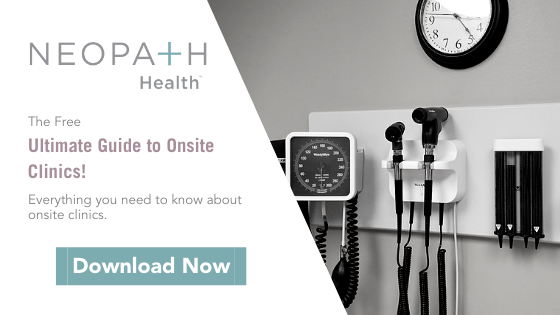Employee health has always been one of your top priorities as a human resources or benefits leader. But after three years in a global pandemic, broader awareness of how workplace stress impacts mental health, and a competitive recruiting landscape, you may be looking for new ways to offer your employees health-related programs and services.
Employee health programs are unique in that what's good for employees is also very good for business. A healthy workforce leads to improved job satisfaction and increased productivity while controlling healthcare costs for your company and your employees.
At NeoPath, we view employee health strategies on a continuum. At one end, there's offering a basic benefits package; at the other end, there's a fully funded and customized health program designed just for your team. Along the continuum are several strategies you can implement to improve employee health at your company.
9 Strategies to Improve Employee Health
Strategy #1: Create a culture of employee health
Let's start at the beginning. What steps are you taking at your company to create a culture of health? Is it clear you prioritize employee health and safety? Do leaders view supporting employee health as part of their role? When employees see that you take their health seriously, they're more apt to take advantage of your health-related programs.
Strategy #2: Provide access to preventive healthcare
Do you offer preventive healthcare services like health screenings to your employees at no or low cost? If you do, are you regularly reminding employees of the importance of preventive care and encouraging employees to take advantage of your services? Preventative healthcare can be as simple as onsite flu shots or as robust as an onsite health clinic.
Strategy #3: Encourage regular physical activity
We all know that regular physical activity helps us achieve and maintain good health. Are you encouraging your employees to take breaks during the day to stretch, go for a walk or participate in other physical activities? Do you offer any incentives for employees who regularly participate in physical activities? Again, this can be as simple as sharing nearby options for walking routes and trails, hosting onsite fitness classes or wellness events, or sponsoring group activities in the community.
Strategy #4: Promote healthy eating habits
Another area that impacts employee health is nutrition. Do you provide healthy snacks in your break room? Do you promote healthy food options in your cafeteria? How about including healthy choices in your vending machines? These are all excellent places to start. You can also create healthy eating challenges and offer healthy cooking demonstrations or classes.
Strategy #5: Implement a stress management program
Untreated stress not only hurts an employee's physical and mental health, but it can also lead to burnout. (Not to mention higher absenteeism and turnover.) Do you offer any stress management programs? Examples include meditation, yoga, or counseling services that help employees manage stress healthily.
Strategy #6: Encourage regular physical activity
Flexible work arrangements such as telecommuting, flexible hours, and job sharing can help employees balance their work and personal lives, reducing stress and improving overall health. Have you created any flexible options for your teams? Are you ensuring leaders offer those options to their teams and support employees who want to work more flexibly?
Strategy #7: Create a smoke-free environment
The CDC estimates that employees who smoke cost employers over $3,000 yearly in lost productivity and medical expenses. Do you encourage employees to quit smoking? Do you provide any resources to help them do so successfully? Start by implementing a smoke-free policy for all indoor areas of your workplace. Extend that policy to offsite gatherings and company-sponsored events. Finally, ensure that your benefits program includes an effective program to help employees quit smoking and remind employees of the program often.
Strategy #8: Encourage mental health days
If the past few years have taught us anything, mental health is just as important as physical health. Do your leaders know the signs of burnout? Do they encourage employees to take mental health days when needed? Talking openly about mental health challenges and ensuring your team knows what employee mental health services you have available is critical. In addition, many companies now provide employees access to counseling or other mental health services.
Strategy #9: Get your employees involved
The most crucial strategy is to get your employees involved in creating programs to support their health. What support and resources do they need? What programs would motivate them to improve their health? Especially for smaller and mid-sized companies, your size makes it easier to tailor programs to meet your employees' needs.
Reduce healthcare costs and improve productivity
Even the most committed companies may hesitate to implement the strategies we've covered here. You may have questions like: How much will this cost? Do we have the resources? Will employees use these programs? Can we measure our success?
After partnering with dozens of mid-sized companies to create employee health programs, we've seen how adding even a few of these strategies makes a difference in the overall health of your team. In our experience, the benefits of employee health programs – like improved employee health and productivity, lower healthcare costs, and increased job satisfaction –outweigh the costs and challenges of implementation.
When you have an experienced partner to guide you, this work is easier than you think.
Need help designing your employee health initiatives?
At NeoPath, we believe there's a better way to provide healthcare to your employees and their families. For over a decade, we've helped mid-market companies design and build onsite primary care clinics. We also offer consultation services to companies with existing onsite clinics, helping them rethink healthcare benefits.
Let's connect today if you need help designing employee health strategies for your company.
.png?width=433&name=NeoPath_2019_logo_2color%20(1).png)




